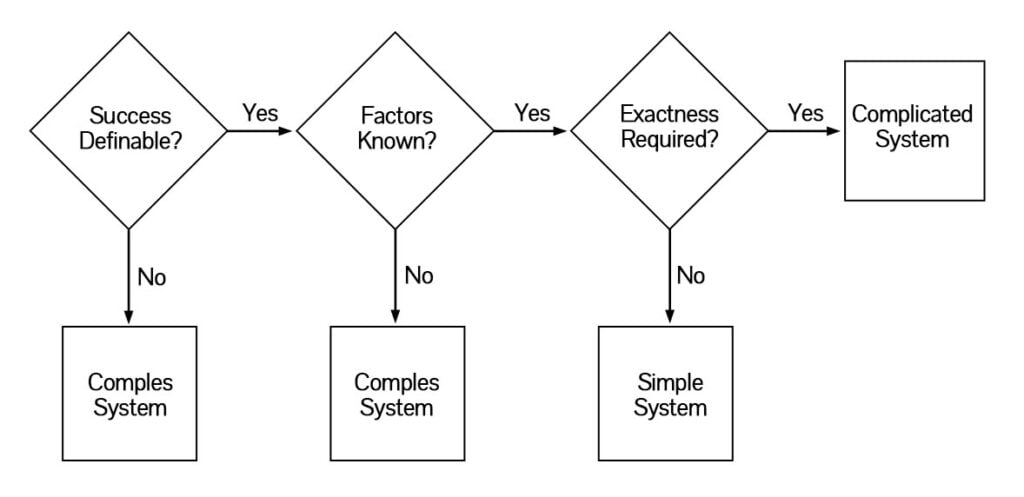Complicated problems can be hard to solve, but they are addressable with rules and recipes, like the algorithms that place advertisements on Twitter feeds. They also can be resolved with Systems and Process Thinking based on predictability and control built on Stochastic Foundations. Statistical Thinking and methods like Six Sigma Management or Logic-based Value Thinking like Lean Management or Design Thinking based on TRIZ etc are some of the approaches. The hierarchical structure that most companies use to command and control employees also reflect an attempt for a structured response at an organizational level to Complicated Problems.
However, the solutions to Complicated problems don’t work as well with Complex problems. Complex problems involve too many unknowns and too many interrelated factors to reduce to rules and processes (Refer article on Higher-Order Skills—www.rlacm.com). For example, a Technological Innovation led disruption like Blockchain is a complex problem. A competitor with a Business Model-led Innovation that disrupts the existing logic of business and value creation — an Uber or an Airbnb — is a complex problem. There’s no algorithm that can tell us how to respond.
The paradox however is, that when facing a complex problem, managers tend to automatically default to complicated thinking using structured problem-solving methods. Instead, they should be “consciously managing complexity.” The same is true for responding to the current COVID 19 pandemic problem which is an Environment Triggered disruption of multidimensional and co-evolutionary nature (new virus strains), whose variables and interactions change with time and are not yet fully understood.
Consciously managing complexity in a business context is broadly a function of four different strategies or tactics. They are:
(1) recognize which type of system you are dealing with;
(2) think “manage, not solve”;
(3) employ a “try, learn, and adapt” operating strategy; and finally, and perhaps most importantly,
(4) develop a complexity mindset.

Before anything can be managed, it must be recognized for what it is. This is especially important for complex versus complicated systems. The manager needs to consciously take a mental step back and classify the issues. It is relatively straightforward to ascertain which elements of the situation are simple, which are complicated, and which are complex. Simply getting the context correct automatically sets the manager on a better course for success.
Obviously, each type of issue needs to be managed in a way that is consistent with its characteristics, as shown in Exhibit 1.0.
Simple systems need to be managed as simple systems. Well-known recipes (7 QC Tools, 5S, etc), procedures, or rules of thumb need to be followed and adhered to. In his bestselling bookThe Checklist Manifesto, author Atul Gawande makes a compelling case for using simple checklists as a way to manage simple systems. Dr. Gawande would likely argue, that even your grandmother should follow a recipe for baking her favourite cake. Simple systems are generally easy to manage, but that also can produce hubris that leads to mistakes.
Complicated systems require more expertise in their management, but as long as the proper expertise is available and used, the attractiveness of complicated systems is that they generally can be successfully managed. Complicated systems, by definition, adhere to a comprehensive and robust set of axioms and rules, and thus it is a matter of making sure that the proper models are being used for the situation at hand. The handling of complicated systems can be managed by the appropriate teams of experts (Six Sigma Master Black Belts, Lean Sensei, etc).

Complex systems are subtle and require a nuanced approach. The one thing that will not work is a rigid, rules-based, complicated approach. Taking the time to make an accurate judgment about the type of management problem at hand helps to avoid the arrogance of complicated thinking. Complicated thinking leads managers to think that they are doing something purposeful when in reality they are not, and in fact, they are likely doing more harm than good. Having the wisdom to know which system is appropriate and the courage to apply the proper techniques for that system are the first and perhaps the most effective steps to gaining a competitive advantage with complexity.

Complex situations do not lend themselves to a solution, and it is folly to spend the time, energy, or effort even to attempt to create solutions. Yet this is exactly how the complicated way of thinking works. It is evident when companies try to optimize complex activities such as marketing strategy, production schedules based on demand, or long-range planning. This form of thinking is especially evident in economics, as politicians all promise solutions to economic ills. Instead, the key is to think “Manage, not Solve”. ”Manage, not Solve” may be a humbling strategy to use, but a lack of humility might be one of the reasons why managers default to complicated thinking. “Manage, not Solve” can also be an unsettling strategy to use, as it implies that you have to rely on your in-the-moment thinking. “Manage, not solve” is based on a strategy of thinking and making relatively spontaneous decisions under uncertainty.
“Manage, not Solve” does not imply that managers should not plan in the face of complexity. In fact, they should do extra planning and develop creative scenarios to understand as many of the possible outcomes as possible. In the end, however, they have to remember Eisenhower’s saying, that in preparing for battle, “plans are useless, but planning is indispensable.” The planning helps one to envisage how things might unfold but cannot explain exactly how things will unfold. The value of planning is in the exercise of planning and the creation of alternative scenarios and alternative responses, not necessarily in the result of the planning.

In a complex environment, it is truly rare that a grand plan or strategy will work as intended. Successful managers, however, are not discouraged by this. They learn from their missteps and use their learning to move forward with a new angle on the problem. They essentially learn as they go. Furthermore, they expect to learn as they go. Complicated thinkers tend to get too intellectually invested in an idea and refuse to let go, despite sometimes overwhelming evidence that the plan is not working. Complexity thinkers have the humility and flexibility not to get trapped into this low-probability strategy.
With a try, learn, and adapt approach, organizations have to allow for mistakes to be made and for risks to be taken. They do not make large bets on grand projects or get too invested in comprehensive plans. A key characteristic of complexity is adaptation. To succeed with complexity, an organization must also be continually adapting. It is important to note that this does not necessarily mean getting better or continually improving. It is quite possible to keep continually improving on all of the wrong things. The case study of Kodak shows that it continued to improve its film products, but when digital photos replaced film, all of the continual improvement was for naught. The same is true for Motorola for its banded pagers based on analog technologies which got obsolete and despite winning the inaugural Baldrige Award for Performance Excellence and introducing Six Sigma to the world had to file for bankruptcy. Adapting means developing a keen sense of how elements of the system are changing and trying new ideas to see how they work in the context of the shifting environment. Ultimately, adapting means changing along with the environment rather than trying to get the environment to change.
For a complicated thinker, adapting to changing and evolving situations can be difficult. It is not easy on the ego to admit that a well-thought-out plan is not going to succeed. However, having the humility and the risk-taking ability to adopt a try, learn, and adapt approach is necessary for success in the presence of complexity.

A complexity mindset is simply a mindset that accepts that complexity exists, accepts that complexity needs to be dealt with differently and accepts that there are certain limitations on what the manager can control in complex situations. Furthermore, and perhaps most importantly, a complexity mindset embraces complexity and the challenges and opportunities that come with dealing with complexity.
While it is not necessary to be a genius to manage complexity, it is helpful to consider for a minute the difference between a genius and someone who is really smart. A little-known fact is that most of Einstein’s mathematical problems were solved by others, including an assistant, Walther Mayer, who solved many of the mathematical equations and did most of the calculations that Einstein’s theoretical musings required. Einstein called Mayer “the calculator.” Mayer was obviously a very knowledgeable and talented mathematician. Einstein was a complex thinker, while Mayer was a very good and very intelligent complicated thinker.
The difference between being super smart and being a genius is relevant for understanding the difference between having a complicated mindset and a complex mindset. Smart people — those who are very efficient in their knowledge of facts and very fast in applying that knowledge — do very well with complicated thinking. Complexity thinkers, however, think differently.
A complexity mindset is a creative mindset. It focuses on what can be, rather than what is. A complexity mindset is an imaginative mindset, as different from a complicated mindset as the difference between thinking and knowing. Thinking is a creative process while knowing is an information-retrieval process. The final aspect of developing a complexity mindset is to learn to embrace complexity and also learn new methods, tools, and techniques to tackle complexity as it is a fact of business. In a highly globalized era marked by disruptive technologies and business models coupled with environmental turbulences, there will be increasing complexity in business. The sooner one recognizes and makes peace with this fact, the better. Complexity is not going to go away. Trying to make complexity disappear or to make it a nonfactor is unproductive and even harmful.
***